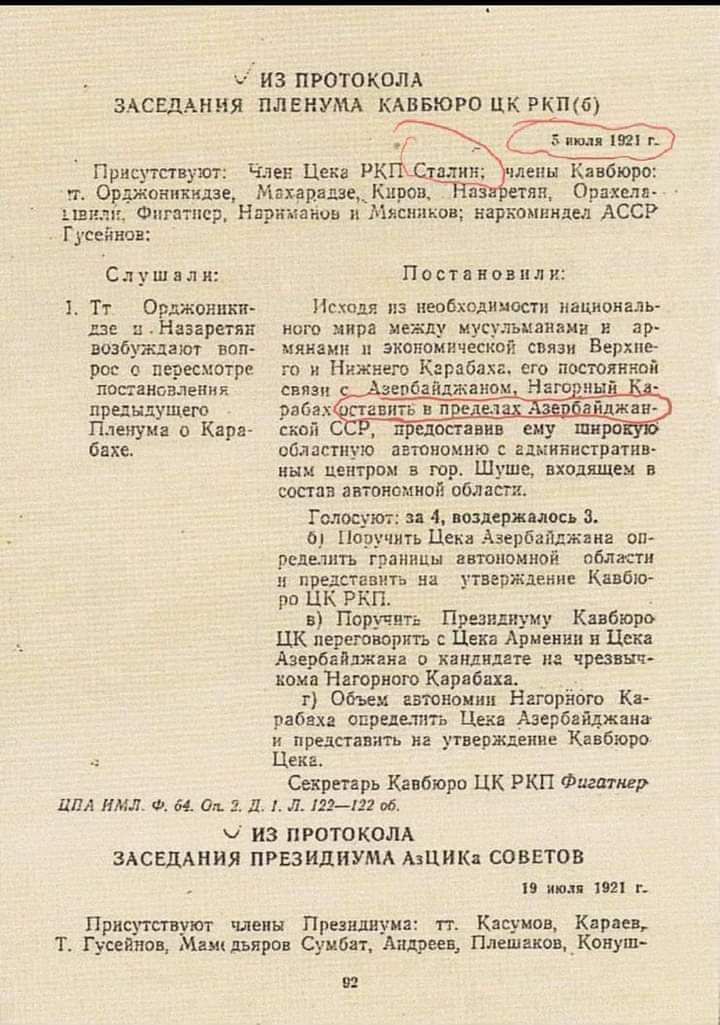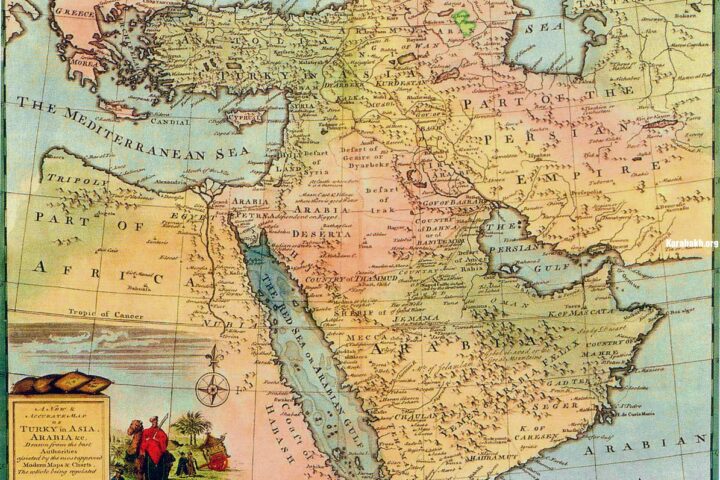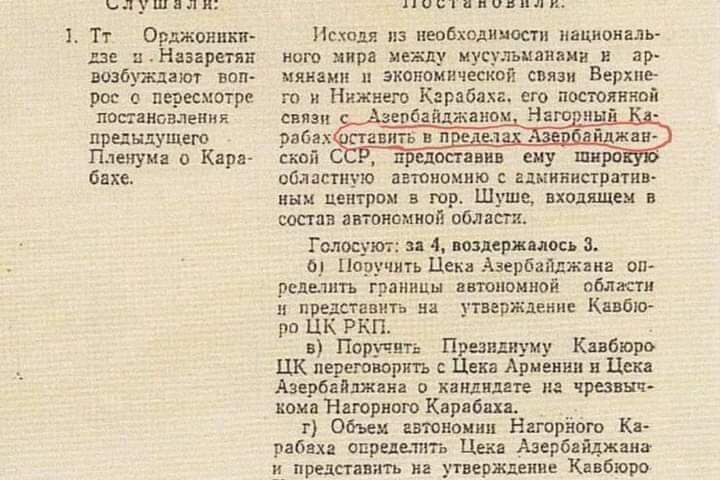Decision of the CEC of Azerbaijan: “An Autonomous Karabakh Region Should Be Set Up in Upper Karabakh with its Center in Khankendi”
On 20 May, 1923, the Karabakh Committee the TCTC set up late in 1922 was ready with its Draft for Settlement of the Karabakh Issue. On 20 June, the draft was transferred to the Presidium of the C.C. Az.C.P. (B.) for further discussion. The authors wrote that the mountainous and valley parts of Karabakh were two economically mutually complementary parts and that the Armenian bias of Nagorno-Karabakh was caused by the absence of qualified Turkic specialists able to achieve better results.
The draft went on to say that “the Center, which concentrates the largest and best part of its people on the oil front, mainly in Baku and its environs, created a vast shortage of Muslim forces. For three years, there was not a single hint at more or less consistent efforts in administration, education, the use of land, transport, cooperation, trade, etc., since the larger part of Karabakh is geographically completely isolated from the Center; the interests and rights of the minority should be observed,” which meant that Karabakh needed administrative reforms.100
The meeting was chaired by Sergey Kirov; Inozemtsev served as its secretary; it was attended by Khanbudagov, Karaev, Mirzoyan, Bagirov, Vareykis, Chagin, Konyushkin, Gasymov, Rakhmanov, Mashkevich, and others. After discussing the issue in detail, the meeting passed the following decision:
(a) Karabakh, both its mountainous and valley parts, should become a single administrative unit;
(b) a commission chaired by Karaev, with Bagirov, Dovletov, Mirzoyan, and Khanbudagov, as its members should study (within three days) the question in the minutest detail and present a draft decision to the Presidium of the C.C. for approval;
(c) A. Karakozov and Kh. Shadunts should attend the meeting of the TCTC to discuss the Karabakh issue;
(d) E. Khanbudagov’s separate opinion should be registered in the protocol.101
The document went on to say that “the Karabakh problem should be ultimately resolved by implementing the decisions of the May (1920) Decree of the CPC of Azerbaijan on making Nagorno-Karabakh an administrative unit in its own right. No other solution can meet the demands of the national minority of Karabakh. If this problem is resolved in any other way, we will be doomed to discuss it again and again.”102 At this time, the decision of the 9th Congress of the Armenian peasants dated 29 April, 1920 was sent to Moscow where the Armenian delegation holding secret talks about the unification of Nagorno-Karabakh and Armenia was supposed to pass it on to the Russian government. The document, however, was ignored.
Careful examination of the relevant documents revealed that the CPC of Azerbaijan did not issue this decree in May 1920; if issued at all, it might have been dated May 1921 when, on 23 May, the plenum of the C.C. of the Communist Party of Armenia appointed A. Ionisyan as Armenian representative in Nagorno-Karabakh. This “misunderstanding” should have triggered a negative response from Azerbaijan, which never happened, while the issue was discussed (strictly confidentially) on 3 June by the plenary session of the Caucasian Bureau. This explains why the May 1921 decree on Karabakh is not listed among the other decrees of the CPC of Azerbaijan.
The decision of the Presidium of the C.C. Az.C.P. (B.) of 20 June to unite the mountainous and valley parts into a single administrative unit was approved in June 1923 by a TCTC plenary session. On 1 July, 1923, a meeting of the Presidium of the C.C. Az.C.P. (B.) suggested that the autonomy of Nagorno-Karabakh, with its center in Khankendi, should be registered in a decree saying that all issues on Nagorno-Karabakh, including border matters, would be dealt with by a special commission. There were plans to set up an executive committee, which required a revolutionary committee of five members headed by Karakozov and a regional party committee of 5 headed by Manutsyan.
The border issues were entrusted to a commission headed by A. Karaev, with Karakozov, Sviridov, Ildrym, and Buniatzade serving as its members, which was expected to present its suggestions to the C.C. Presidium within seven days.103
On 4 July, the CEC Presidium confirmed the commission’s suggestions. The first paragraph of the document said: “The autonomous Karabakh region should be set up in Upper Karabakh with its center in Khankendi.”104
On 7 July, 1923, the Central Executive Committee of Azerbaijan crowned three years of preparatory work with a decree on setting up the Nagorno-Karabakh Autonomous Region (NKAR) as part of the Republic of Azerbaijan. The decree signed by Deputy Chairman of the CEC of Azerbaijan M. Gasymov and CEC Secretary M. Khanbudagov105 said in particular that “the workers’ and peasant revolution and Soviet power see it as their task to eliminate all forms of national oppression and inequality and replace national enmity and hatred with international solidarity of the working people and fraternal cooperation of peoples in a single state union. To fulfill this task, the Central Executive Committee of the Soviets of Azerbaijan rules that ‘an autonomous region should be established in the Armenian part of Nagorno-Karabakh as a component of the A.S.S.R. with its center in the Khankendi settlement.’”106
Bashir Buniyatov: “All the Muslims of Karabakh See Me as a Traitor”
Two weeks later, a joint meeting of the Presidium of CEC and CPC of Azerbaijan endorsed the names of those who would work in the revolutionary committee: Karakozov (Chairman); Buniyatov, Kostonyan, Kafiev (Kafiyan), and Chalyan.107 Karakozov, Buniyatov, Chalyan, Vareykis, and Manutsyan were entrusted with the task of drafting a Statute for the NKAR; Karakozov was instructed to organize the work and complete it in seven days.108
Buniyatov was the only Azeri among the five members of the newly established revolutionary committee; his contribution could be described as mainly formal. In January 1923, he was appointed as chairman of the Shusha Uezd Executive Committee. Several months later, in September, being keenly aware of the ambiguity of his position, he asked Kirov to rescue him from moral death by relieving him from his post when the situation in the region improved, which would make his continued services unnecessary. “All the Muslims of Karabakh see me as a traitor,” he wrote.109
The urban population of Shusha was dead set against autonomy for the mountainous part of Karabakh; early in 1923, after Buniyatov’s address at a meeting of the people of Shusha, they sent a delegation to Baku to inform the Center that the autonomy of Karabakh should be radically revised. S. Kirov panicked and demanded “urgent explanations” from Karakozov and Buniyatov.110
The Agdam, Jebrail, and Kurdistan uezds were set up in the territories beyond the borders of the new autonomous region.111
The idea of a “Kurdish autonomy” bordering on the NKAR was born in the border commission on the day the decree of the CEC of Azerbaijan was published.112 On 16 July, the meeting of the Presidium of the C.C. Az.C.P. (B.) abandoned the idea and set up a Kurdistan Uezd instead; on 21 July, this was approved by the CEC and CPC of Azerbaijan.113
The population census of 1937 (the first one to be conducted in the Soviet Union, the results of which were annulled for political reasons) revealed that there were 10,878 Kurds in Azerbaijan and 22,313 Kurds in Armenia.114
How Khankendi Became the Center of the Autonomous Region of Nagorno-Karabakh
A careful examination of the decree of the CEC of Azerbaijan will reveal a discrepancy between it and the decision of the Caucasian Bureau of 5 July. The decision said that broad autonomy was granted to the region, with its administrative center in Shusha.115 The decree, on the other hand, said that “an autonomous region should be established in the Armenian part of Nagorno-Karabakh as a component of the A.S.S.R. with its center in the Khankendi settlement.”116
Why did this happen? On 7 July, the day the CEC Decree was published, Shusha did not belong to the region. Two weeks later, however, on 21 July, 1923, the joint meeting of the Presidium of the CEC and CPC of Azerbaijan, after listening to D. Buniatzade’s report on the Karabakh issue, passed a decision of eight points which said in particular that:
“(a) the plundered Russian villages of the Skobelev Society should be included in the territory of autonomous Karabakh;
“(b) the city of Shusha should be included in the Nagorno-Karabakh Autonomous Region.”117
On the other hand, Shusha was the only city in the territory of the newly formed autonomous region with a predominantly Azeri population. This explains why the Armenians preferred the Khankendi settlement as the regional center (in the past its population had been predominantly Muslim, whereas by the time the NKAR was set up, it was registered as a small Turkic settlement). The Armenians obviously feared that the Azeri population of Shusha would establish its control over the power structures.
The settlement status of a very small village was prompted by the far-reaching plans to transform it into a “capital.”
In July 1920, the idea of turning Khankendi into a regional center began gaining momentum to develop, by the fall of 1922, into practical measures. The Armenian (mainly Dashnak) committee of Nagorno-Karabakh set up back in April 1920 was transformed, with ease, into an uezd committee of the Communist Party of Armenia.118
On 11 July, its chairman, S. Ambartsumyan, and one of the officials informed the C.C. of the Communist Party of Azerbaijan that they were carrying out party work separately from their Muslim comrades (because they knew next to nothing about how to work in the Muslim milieu). They pointed out in the same report that “the confusion in the party threatens to destroy all the organizational efforts in Karabakh. We need a center in Khankendi that will geographically and economically join all the districts of Karabakh.”119
During the first months of Soviet power, all sorts of Armenian organizations had obviously selected Khankendi as the regional center. In December 1922, the Communist faction of the CEC and C.C. Az.C.P. (B.) approved the members of the Karabakh Committee which was entrusted, among other things, with the task of opening a school and a hospital in Khankendi.120
This makes us wonder what the Azeri population of Shusha thought about this?
On 9 August, 1923, the CEC of Azerbaijan received a letter written by empowered representatives of the population of Shusha R. Aliev, I. Musaev, B. Sarabi, and G. Shamshiev on behalf of the people of Shusha. It said that “for many years (over a century), Karabakh and all the other parts of Czarist Russia suffered under the yoke of Russian militarism” and protested against the newly established NKAR and the inclusion of the city of Shusha and the nearest Muslim villages in it.
The authors asked the authorities to take into account that “the population of the city of Shusha and the nearest Muslim villages … believes it expedient to let it be known that they are closely connected in this respect and economically with the population of the newly founded Kurdistan Uezd. They empowered us to ask for the city and the nearest villages to be joined to this uezd. On the strength of the above and being convinced that the Soviet government will never ignore the interests of the local people and will always satisfy their justified requests, we ask you to satisfy the requests of the people of Shusha and the nearest villages and join them to the Kurdistan Uezd.”
The empowered representatives concluded the letter with the following: “If for state or other considerations it is impossible to satisfy our request, we ask you to preserve the city of Shusha as the center of Nagorno-Karabakh and not to transfer the center to Khankendi.”121
As soon as the Armenian leaders of the autonomous region learned about the letter, they telegraphed Sergey Kirov to dismiss it as a provocation. Secretary of the Shusha Uezd Executive Committee S. Manutsyan wrote that it proved beyond a doubt that the traders were merely concerned about losing their profits if Shusha stopped being the uezd center.122
The people in Shusha refused to succumb to the pressure of the Armenian leaders and went on with their attempts to move out of the autonomous region. On 4 January, 1924, plenipotentiary representatives of the Shusha population M. Mirbagirov and A. Guliev sent a telegram to the Congress of the Soviets of the Transcaucasus (copies were sent to Kirov, Bagirov, and Orjonikidze) to demand, on behalf of the multi-thousand population of Shusha, that the city be made part of the Kurdistan Uezd.123
On 17 April, 1924, under pressure from the Azeri population of the city, the C.C. Az.C.P. (B.) instructed the Karabakh Regional Committee of the Communist Party of Azerbaijan to set up an administrative unit based on Shusha and the nearest Turkic villages.124








